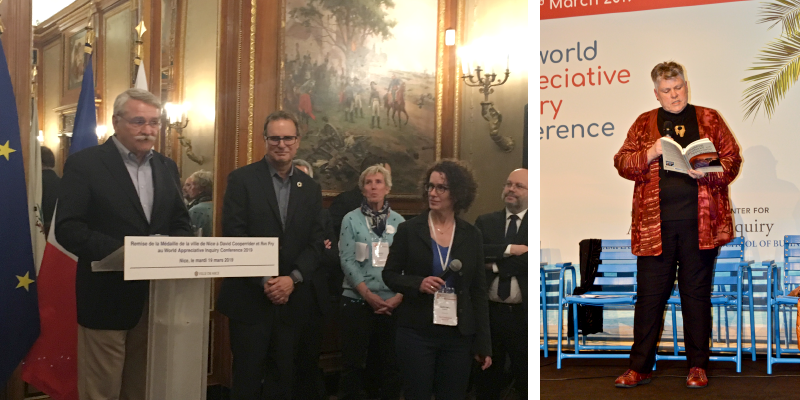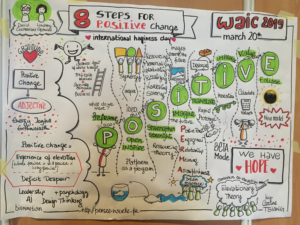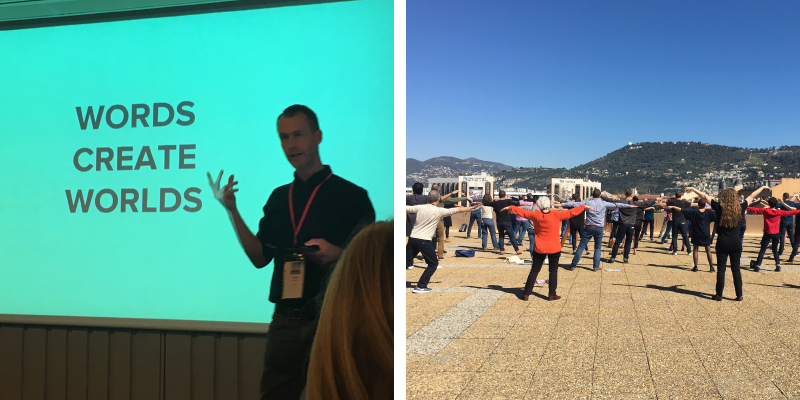Appreciative Voices in Times of Change
Better to illuminate than merely to shine, to deliver to others contemplated truths than merely to contemplate. Saint Thomas Aquinas
Ask any Appreciative Inquiry practitioner what AI is, and the words of St. Thomas Aquinas resound throughout their explanation: you will hear them talk about it as a process of active engagement that considers organisational change in the context of “what works” with a clear focus on strengths, not weaknesses. You will also hear about the way it highlights and elevates the core aspects that “give life” to the organisation. Most emphatically you’ll hear how AI illuminates the positive core within the organisation and delivers this in a way that results in positive change for individuals, teams, groups and communities. It does all this by creating an environment that supports and encourages individuals to be and to share their best through collective learning, especially in times of change. The transformational elements of narrative directed towards positive change are a key aspect of AI, especially as it elicits how we feel, how we comprehend our world, and the meaning we attribute to what is happening around us and within us. Every effort is made to create a discourse that inspires people to recognise and live their best.
The quote from Saint Thomas Aquinas is one that I have admired since my teenage years and have used as a mantra all my adult life. In many ways, my connection to Appreciative Inquiry stems from all that Aquinas’s quote elicits, emphasising the importance of discernment and contribution. This quote came to mind on New Year’s Eve 2020 while riding my bicycle around my neighbourhood and reflecting on the year that was. As I began to make my way home, I came across a huge mural painted on an old silo by a local artist, Loretta Lizzio. It is a copy of the iconic photo taken by Hagen Hopkins in March 2019 depicting the moment New Zealand Prime Minister Jacinda Ardern embraced a Muslim woman several days after more than 50 people lost their lives in a terrorist attack in Christchurch, New Zealand.
I looked for a good hour at the mural, trying to fathom the impact of what had happened, the lives lost, and the grief experienced by many. The image, along with Aquinas’s quote, stayed with me for the rest of the day and late into the evening. There has been so much grief around the world, especially in 2020 where we experienced numerous catastrophic incidents, including the Covid-19 pandemic that has affected almost everyone , and is expected to do so for years to come. As with any crisis, change is inevitable. One of the challenges is to try and comprehend what has happened in order to make sense of it while exploring ways to understand it that give hope for the future.
The true, the good, the better, the possible
The mural provides a glimpse of a way forward ,reflecting the kind of leadership that takes the time to embrace grief while understanding and planning for the challenges that lie ahead. This is where I see AI as an invaluable approach in times of crisis. As David Cooperrider puts it, appreciative leadership is:
…the capacity to see the best in the world around us… the capacity to see with an appreciative eye the true and the good, the better and the possible. (Creelman, 2001)
This is what I see in the mural: truth, empathy, hope and deep acknowledgement of what has occurred, yet a will and commitment to move forward with compassion. One of the defining points of wisdom of AI is that the question sets the direction; in his early research, David Cooperrider identified that: “…the more we started asking questions about the true, the good, the better, and the possible, the more we were able to participate in the creation of positive change” (Creelman, 2001).
Amplifying hope where hope has been diminished
Appreciative Inquiry is as much a world view as it is a strengths-based approach geared towards positive change, and therefore well positioned to amplify hope in times where hope has diminished. The effectiveness of AI stems from its consideration around what has been working well; that reality is created in the moment; and that people have more confidence moving towards the unknown (future) when elements of the known (past) are carried forward with them. This powerful experience of the connection between past, present and future along with questions designed to explore the true, the good, the better and the possible is instrumental in bringing about positive change.
Over the past five years I have had the privilege of engaging with AI practitioners located across the globe who have contributed articles to the AI Practitioner journal based on how they have approached challenges with an appreciative mindset, an appreciative lens and an appreciative voice. These practitioners have worked across many sectors, including the community, health, education and business. They have, indeed, illuminated more than merely shone, and delivered contemplated truths rather than merely contemplating!
I have included below a brief overview of inspirational work achieved by three Appreciative Inquiry practitioners. Their full articles as well as articles written by other inspirational AI practitioners are available at www.aipractitioner.com
PETRA VAN LEEUWEN | THE NETHERLANDS
AI and Strengths-based Social Work: Perfect Partners
AI Practitioner | Volume 18, Number 2 – May 2016
Homelessness
Equipped with questions that explored the true, the good, the better,and the possible, Petra Van Leeuwen and her colleagues in the Netherlands developed a strengths-based approach designed to support homeless women experiencing mental health and addiction problems. Entitled the “Eight Steps Model” (ESM), the women were assisted through individually tailored support plans that addressed their overall wellbeing. The model was so successful that 75% of homeless shelters across the Netherlands incorporated it into their care strategies. ESM was designed to see the person, not the problem. It was several years after developing the ESM that Petra learned about Appreciative Inquiry and adopted it into her practice. She commented that the ESM shares similar principles and processes to AI and they work perfectly together. A key aspect of the ESM is to consider a person’s strengths and the challenges that they face across significant areas of their life. The questions used are strength-based in nature, incorporating hopes, dreams and meaningfulness.
NELLY NDUTA NDIRANGU | KENYA
Cultivating Appreciative Communities
AI Practitioner | Volume 19, Number 3 – August 2017
Segregation
A fundamental aspect attributed to Appreciative Inquiry working toward positive change is its unwavering focus on the positive core. Nelly Nduta Ndirangu’s commitment to generate collaborative communities by identifying the positive aspects within each community, bringing them together and creating common ground through their differences is a heartening example of successful appreciative practice in times of segregation. Despite the history of ethnic divide, Nelly and her team used the AI process to identify and support the potential within each individual and in whole communities. Apart from working through the disparities across communities, the peace-building programs she has developed and implemented with her teams in Kenya have also extended to working with victims of post-election violence and resettlement programs for internally displaced families. Working closely with a team of counsellors through the Kimo Wellness Foundation, Nelly and James Karanja, a Taos associate member, lead the development of a tailor-made comprehensive AI trauma-based healing program for people traumatised by terrorism, landslides, road accidents and school fires.
GUDRÚN SNORRADÓTTIR | ICELAND
The Gift of the Human Spirit: Resilient greetings from your friends in Iceland
AI Practitioner | Volume 22, Number 2 – May 2020
Pandemic
In this time of the Covid-19 pandemic, good leadership is crucial for a hopeful future. Gudrún Snorradóttir highlights the importance of a solution-based mindset and harnessing the strength of community. The pandemic is a testament to the fact that we cannot always control what comes. However, when we come together with compassion and planning – and the right set of questions – we embolden each other to the point of positive action and a co-created environment of possibilities replete with shared meaning. Gudrún places great emphasis on human connection, the choice to be resilient, and keeping a clear focus on what we can control in the face of the pandemic. It is clear that the impact of Covid-19 will continue for some time to come, and it is here that Gudrún underlines the importance of good leadership that encourages and supports an environment that ensures collective wellbeing.
REFERENCES
Creelman, D. (2001) An Interview with David Cooperrider. Retrieved from
https://www.centerforappreciativeinquiry.net/wp-content/uploads/2011/05/interview-with-david-cooperrider_Center-for-Appreciative-Inquiry.pdf

Keith is a registered psychologist with the Psychology Board of Australia (PsyBA) and associate fellow with the Australasian College of Health Service Management (ACHSM). He has designed and implemented health and wellbeing frameworks across the community, health and education sectors. Keith’s current focus is on developing his work in Appreciative Dialogue (ApDi) to assist individuals in moving from self-doubt to inspired positive action.



 Keith is a registered psychologist with the Psychology Board of Australia (PsyBA) and associate fellow with the Australasian College of Health Service Management (ACHSM). He has designed and implemented health and wellbeing frameworks across the community, health and education sectors. Keith’s current focus is on developing his work in Appreciative Dialogue (ApDi) to assist individuals in moving from self-doubt to inspired positive action.
Keith is a registered psychologist with the Psychology Board of Australia (PsyBA) and associate fellow with the Australasian College of Health Service Management (ACHSM). He has designed and implemented health and wellbeing frameworks across the community, health and education sectors. Keith’s current focus is on developing his work in Appreciative Dialogue (ApDi) to assist individuals in moving from self-doubt to inspired positive action.
 Neena Verma, Ph.D., PCC is a scholar-practitioner of AI-based OD. She is an ICF-PCC credentialed coach, specialising in leadership, systemic and transcendence coaching. An accredited sensitivity trainer and certified AI practitioner, she has developed a number of coaching and OD models. As well as extensive editing experience, including the February 2013 and November 2016 issues of AIP, Neena has authored two books and numerous articles.
Neena Verma, Ph.D., PCC is a scholar-practitioner of AI-based OD. She is an ICF-PCC credentialed coach, specialising in leadership, systemic and transcendence coaching. An accredited sensitivity trainer and certified AI practitioner, she has developed a number of coaching and OD models. As well as extensive editing experience, including the February 2013 and November 2016 issues of AIP, Neena has authored two books and numerous articles. Jakob van Wielink, M.A., is an international grief counselor and executive coach. He is a partner at De School voor Transitie in the Netherlands, a faculty mentor at the Portland Institute for Loss and Transition in the USA and is affiliated with IMD Business School’s (Advanced) High Performance Leadership Program in Switzerland and Singapore.
Jakob van Wielink, M.A., is an international grief counselor and executive coach. He is a partner at De School voor Transitie in the Netherlands, a faculty mentor at the Portland Institute for Loss and Transition in the USA and is affiliated with IMD Business School’s (Advanced) High Performance Leadership Program in Switzerland and Singapore. Leo Wilhelm, M.Sc., is a grief counselor, author, executive coach and advisor to De School voor Transitie in the Netherlands.
Leo Wilhelm, M.Sc., is a grief counselor, author, executive coach and advisor to De School voor Transitie in the Netherlands. Denise van Geelen-Merks, M.Sc., is a psychologist, coach and couples’ therapist, and is licensed for systemic work in the Netherlands.
Denise van Geelen-Merks, M.Sc., is a psychologist, coach and couples’ therapist, and is licensed for systemic work in the Netherlands.
 In March 2019, in a wonderful meeting in Barcelona generously organized by the IDeIA Network, I heard one of the facilitators commenting on how she, over many years, “had lived in the questions”. That phrase “woke up” in my reflection and made me realize that, with the practice of AI, I could learn to challenge ideas in a different way, letting go of the urgency to arrive at the correct answer and win the competition.
In March 2019, in a wonderful meeting in Barcelona generously organized by the IDeIA Network, I heard one of the facilitators commenting on how she, over many years, “had lived in the questions”. That phrase “woke up” in my reflection and made me realize that, with the practice of AI, I could learn to challenge ideas in a different way, letting go of the urgency to arrive at the correct answer and win the competition.




